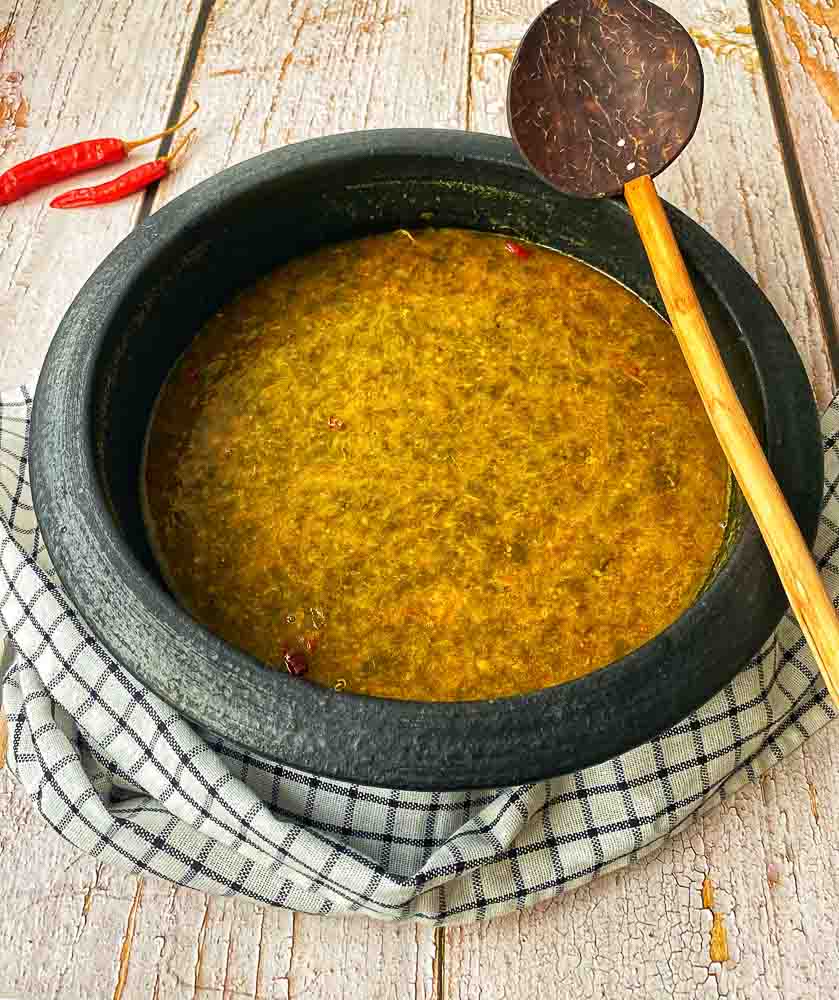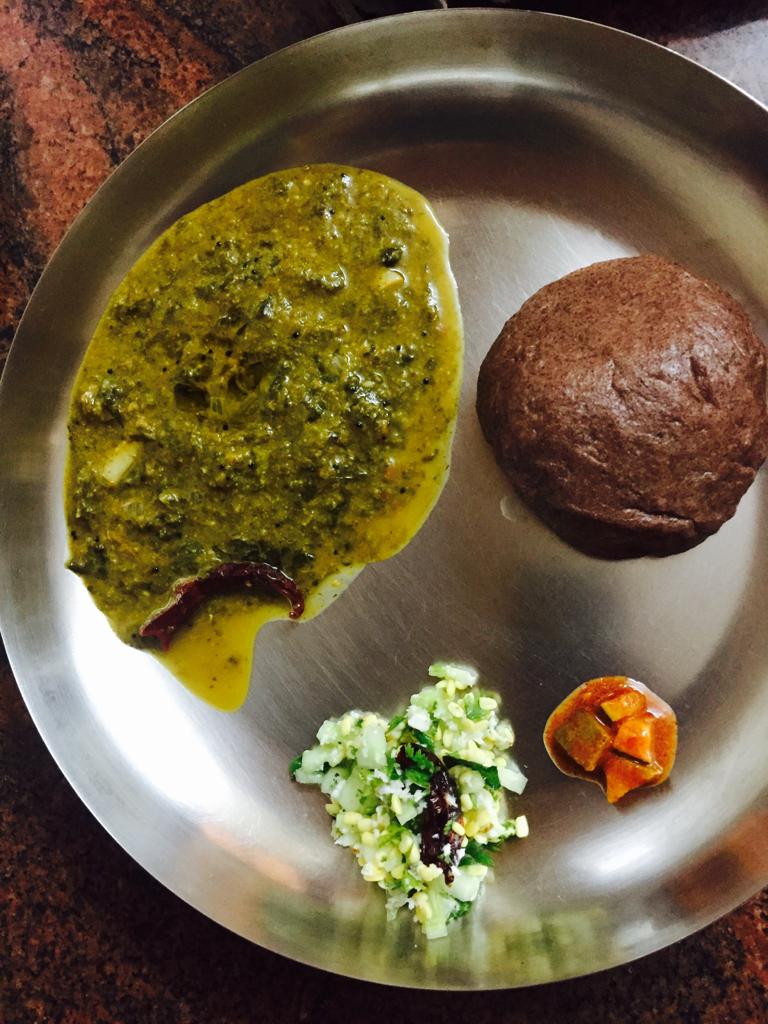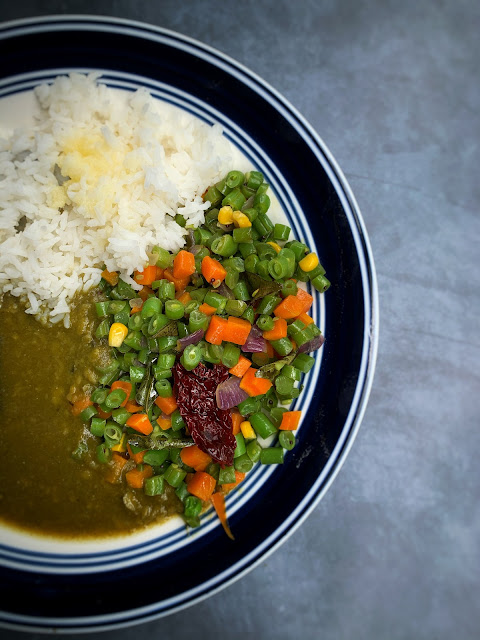Soppu Saaru, also known as Keerai Sambar or simply leafy vegetable stew, is a nutritious and comforting dish from the South Indian culinary tradition, particularly from the region of Karnataka. It’s a wholesome and hearty concoction that combines the goodness of green leafy vegetables, often referred to as “soppu” in Kannada, with the flavors of a variety of spices and lentils.
The dish commonly utilizes greens such as spinach, amaranth, or dill, known respectively as palak, thotakura, and sabbasige soppu in South India. These greens are rich in vitamins and minerals, making Soppu Saaru not only delicious but also beneficial for health.
The base of the soup/stew is typically made with pigeon peas (toor dal), which are cooked and mashed to give the Saaru a thick, creamy texture. The incorporation of a masala – a blend of spices that usually includes cumin, coriander, garlic, and chilies, among others – infuses the dish with depth and heat, contributing to its distinctive taste.
Soppu Saaru Recipe


Soppu Saaru
Equipment
- 1 electric pressure cooker
Ingredients
- 1/2 cup split pigeon peas rinsed well in cool water, drained
- 21/2 cups water divided
- 1 tablespoon rasam powder
- 11/2 tablespoons shredded fresh coconut or frozen, thawed to room temperature
- 1 tablespoon vegetable or corn oil
- 1/2 teaspoon mustard seeds
- 1 teaspoon cumin seeds
- 1/4 teaspoon asafoetida
- 1/2 cup finely chopped onion
- 2 garlic cloves finely chopped
- 2 green chiles slit lengthwise
- 2 tablespoons finely chopped fresh dill see Ingredient Tip
- 3 cups packed mixed greens such as spinach and beet greens
- 2 teaspoons tamarind paste
- 1 teaspoon powdered jaggery
- 2 teaspoons salt
Instructions
- In an electric pressure cooker, such as the Instant Pot®, or stovetop pressure cooker or pressure pan, combine the pigeon peas and 11⁄2 cups of water.
- For an electric pressure cooker, lock the lid into place and make sure the valve is in the Sealed position. Select the Bean/Chili function and set the time to 30 minutes (or select Manual and cook for at least 20 minutes on High Pressure). Let the pressure release naturally. For a stovetop pressure cooker, place it over medium-high heat and put the lid on. Ensure the sealing ring is on and place the weight on. Pressure cook until the cooker “whistles” 3 times. Let the pressure release naturally.
- Carefully unlock and remove the lid and let the pigeon peas cool. Transfer them to a medium bowl and mash them with a potato masher. Set aside. Wash the pressure cooker pot.
- In a blender, combine the rasam powder and coconut. Pulse a few times to grind. With the blender running, slowly add the remaining 1 cup of water until a smooth paste forms. Set aside.
- On your electric pressure cooker, select Sauté or place a stovetop pressure cooker over medium heat, and heat the vegetable oil.
- Add the mustard seeds, cumin seeds, and asafoetida. Cook until the mustard seeds begin to sputter, about 1 minute.
- Add the onion, garlic, and green chiles. Cook for about 5 minutes, or until the onion is translucent.
- Add the dill, mixed greens, tamarind paste, jaggery, salt, and coconut paste and stir until mixed well. Cook for 2 minutes. Stir in the split pigeon peas.
- For an electric pressure cooker, lock the lid into place and make sure the valve is in the Sealed position. Select Cancel, then Pressure Cook or Manual and set the time to 10 minutes on High Pressure. Let the pressure release naturally. For a stovetop pressure cooker, place it over medium heat and place the lid on. Ensure the sealing ring is on and place the weight on. Pressure cook until the cooker “whistles” 2 times. Let the pressure release naturally.
- Carefully unlock and remove the lid. Mash the mixture with a potato masher.
Notes
combination of beet greens, spinach, and dill. Dill adds a strong flavor; reduce it to 1 tablespoon if you prefer.
Cooking Tips about Soppu Saaru

- Select Fresh Greens: The freshness of the greens is key to a great Soppu Saaru. Choose vibrant, fresh leafy greens such as spinach, amaranth, or dill for the best taste and nutritional value.
- Properly Prep Greens: Wash the greens thoroughly to remove any dirt or grit. You may want to blanch them in boiling water for a minute to reduce bitterness and then chop them finely.
- Cook Lentils Properly: The lentils should be cooked until they’re soft and mushy, as they provide the base for this hearty dish. Pre-soaking can help speed up the cooking process.
- Balance the Spices: The masala for Soppu Saaru usually includes a combination of cumin, coriander, garlic, and chilies. Make sure to grind these spices into a consistent paste for even distribution throughout the dish.
- Use Tamarind Juice Sparingly: Add tamarind juice to introduce a tangy flavor that can complement the earthy taste of the greens and the spices. Be cautious with the quantity to not overpower the other flavors.
- Saute the Masala: Fry the ground masala in oil before adding it to the cooked lentils and greens. This step enhances the flavors and releases the aromatic compounds in the spices.
- Master the Tadka: A well-executed tempering (tadka) of mustard seeds, curry leaves, hing (asafoetida), and dry red chilies in hot oil adds a layer of complexity and depth. Pour this over the cooked lentils and greens mix.
- Adjust Consistency: Soppu Saaru can vary in consistency from thin to moderately thick. Adjust the amount of water based on how you prefer your Saaru. It should coat a spoon but still be pourable.
- Simmer to Combine Flavors: Let the Sagu simmer for a few minutes after combining all the components. This allows the flavors to meld together beautifully.
- Season to Taste: Always end by adjusting salt and spice levels to ensure the dish matches your personal preference. Each batch of greens may have a different level of bitterness, so tweak accordingly.
- Serve with a Suitable Accompaniment: Traditionally, Soppu Saaru is served with steamed rice, but it can also go well with ragi mudde (finger millet balls) or warm chapatis.
Serving suggestions about Soppu Saaru

- Over Steamed Rice: Poured over hot steamed rice, Soppu Saaru makes a complete meal, its soupy consistency soaking into the grains for a satisfying experience.
- With Ragi Mudde: In Karnataka, it is often enjoyed with ragi mudde (finger millet balls), which are perfect for dipping and soaking up the flavorful Saaru.
- As a Side to Flatbreads: While rice is more common, Soppu Saaru can also accompany flatbreads such as chapati, roti, or akki rotti (rice flour flatbread), providing a saucy side that complements the dry texture of the breads.
- With a Dollop of Ghee: Adding a small spoonful of ghee can enrich the taste of Soppu Saaru, giving it an extra layer of flavor and aroma.
- Sprinkling of Fresh Coconut: Some prefer garnishing the Soppu Saaru with freshly grated coconut for a subtle sweetness and variety in texture.
- Accompany with Pickles or Papadums: A tangy pickle or crispy papadum can contrast the mushy consistency of Soppu Saaru and add a crunchy element to the meal.
- Pair with Yogurt or Buttermilk: A side of cooling yogurt or buttermilk can balance the warm spices typically found in this dish.
- Topped with Fresh Herbs: Chopped cilantro or curry leaves sprinkled just before serving can bring freshness and visually perk up the dish.
- Include a Side Salad: A light and simple salad of sliced onions, cucumbers, and tomatoes drizzled with lemon and seasoned with salt could serve as a refreshingly crisp side.
- Serve as Part of a Thali: Make Soppu Saaru a part of a larger thali, complementing it with other dishes such as vegetable curries, dal, chutney, and dessert for a complete dining feast.
Top 5 FAQs about Soppu Saaru

- What greens work best in Soppu Saaru? Spinach, amaranth, and dill are some of the most commonly used greens. You can also use other leafy vegetables that are locally available and fresh to capture the essence of this dish.
- What type of lentils are used in Soppu Saaru? Pigeon peas (toor dal) are traditionally used for their creamy texture and flavor. They form the base of the Saaru and are cooked until mushy before being mixed with the greens and spices.
- Can Soppu Saaru be made without tamarind juice? Tamarind juice is added for a touch of tanginess, but if it’s unavailable or if you prefer not to use it, you can substitute it with tomatoes for the acidity or simply skip it according to your taste preference.
- Is Soppu Saaru spicy, and can I make it less spicy? The heat level of Soppu Saaru depends on the amount and type of chilies used. To make it less spicy, reduce the number of green chilies or red chili powder in the recipe. Alternatively, you can remove the seeds from the chilies to lower the heat.
- How can I store leftover Soppu Saaru, and how long will it last? Leftover Soppu Saaru can be stored in an airtight container in the refrigerator for up to 2-3 days. Reheat on the stove or in a microwave before serving. It can also be frozen for longer storage, though the texture of the greens may change slightly upon thawing.
Soppu Saaru stands as a nutritious and flavorsome stew. Its rich texture and depth of flavor make it an essential part of South Indian cuisine, particularly in Karnataka. The delightful combination of leafy greens and lentils not only offers a comforting experience but also provides significant health benefits, making it both a hearty meal and a wise choice for those who are health-conscious.

Leave a Reply